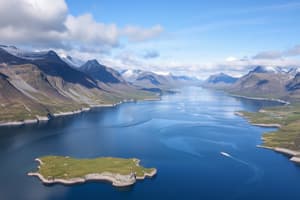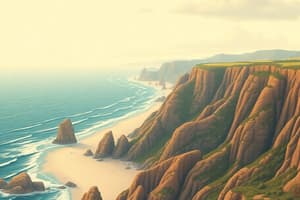Podcast
Questions and Answers
Which of the following processes primarily contributes to the formation of a natural arch along a coastline?
Which of the following processes primarily contributes to the formation of a natural arch along a coastline?
- The deposition of sediment by tides, creating a bridge between a headland and the mainland.
- The hollowing out of a headland by wave action. (correct)
- The accumulation of sand and pebbles along the coast by wave action.
- The collapse of a stack due to weathering and erosion.
How does the tidal range of a coastline primarily influence sediment deposition patterns?
How does the tidal range of a coastline primarily influence sediment deposition patterns?
- A high tidal range concentrates sediment near the shoreline, creating smaller beaches.
- A high tidal range allows waves to deposit sediment further inland. (correct)
- The tidal range has no significant impact on sediment deposition patterns.
- A low tidal range results in sediment being deposited further inland due to stronger wave action.
What is the primary difference between a 'spit' and a 'tombolo' in coastal landforms?
What is the primary difference between a 'spit' and a 'tombolo' in coastal landforms?
- A spit is formed by wind action, while a tombolo is formed by wave action.
- A spit is an elongated ridge of sand extending into the water from the mainland, while a tombolo is a ridge of sand connecting an island to the mainland. (correct)
- A spit is a ridge of sand connecting an island to the mainland, while a tombolo is an elongated ridge of sand extending into the water from the mainland.
- A spit is a steep rock face shaped by the sea, while a tombolo is a small island made of rock.
Which of the following best explains how waves contribute to coastal erosion?
Which of the following best explains how waves contribute to coastal erosion?
How do coastlines with large beaches differ from those with small, narrow beaches in terms of wave energy?
How do coastlines with large beaches differ from those with small, narrow beaches in terms of wave energy?
Flashcards
What is a Coastline?
What is a Coastline?
The meeting point of land and the seas or oceans, including beaches, cliffs, and estuaries.
What is a stack?
What is a stack?
A narrow column of rock resulting from the collapse of a natural arch.
What is a headland?
What is a headland?
Tapering strip of land jutting into the sea.
What is a tombolo?
What is a tombolo?
Signup and view all the flashcards
What are tides?
What are tides?
Signup and view all the flashcards
Study Notes
- A coastline is where land meets the sea or ocean
- Coastlines include beaches, cliffs, capes, caves, bays, and estuaries
- They line up at the edge of the land and are located close together
Coastal Features
- Natural arch: An arch hollowed out of a headland by the sea
- Beach: Accumulation of sand or pebbles along a coast
- Cave: Natural underground cavity from slow dissolution and erosion of rock by water
- Cliff: Steep rock face shaped by a sea
- Dune: Accumulation of sand shaped by the wind
- Headland: Tapering strip of land jutting into the sea
- Lagoon: Shallow expanse of seawater separated from the sea by a ridge of sand or barrier island
- River estuary: Mouth of a river influenced by tides, forming a variable indentation in the coastline
- Rocky islet: Small island made of rock
- Sand island: Exposed summit of a sand deposit formed near or far from a shoreline
- Skerry: Rock tip just above the water's surface
- Spit: Elongated ridge of sand or pebbles extending into the water
- Stack: Needle-shaped column from the collapse of an arch
- Tombolo: Ridge of sand joining an island to the shoreline
Changing Coastlines
- Waves, tides, and currents shape coastlines through erosion and deposition
- Eroded material (shells, sand, seaweeds) can become permanent parts of the coast
- Harder materials like granite resist erosion, keeping coastlines stable for centuries
- Tides deposit sediment where the ocean rises and falls
- Large tidal ranges deposit material further inland versus smaller ranges
- Larger waves have more energy, moving greater amounts of sediment
Wave Energy and Coastlines
- Coastlines featuring large beaches allow waves to dissipate energy over a wider area
- Coasts with smaller, narrow beaches concentrate wave energy, leading to a more weathered appearance
- Sandy beaches erode, while strong waves can crack rocky coastlines
Additional Factors
- Coasts show natural events like weather and changing sea levels
- Storms often lead to flooding in coastal areas
- Coastal plains are flat, low-lying areas that become visible with decreasing sea levels
- Pollution, oil spills, and garbage harm coastal aesthetics and marine life
Studying That Suits You
Use AI to generate personalized quizzes and flashcards to suit your learning preferences.



